14
Sutherland Steam Mill Today, Denmark, Nova Scotia, Canada2010
Denmark, Nova Scotia, Canada
 Credits:
Credits:S. Brinkhurst
15
In 1891, at the age of 25, Alexander Sutherland started his business in Denmark. He chose Denmark because of its supply of timber and easy access to the Oxford Junction-Pictou Short Line railway, which had opened in 1889. He then decided to purchase a portable steam power mill from George White and Sons of London, Ontario. This produced the lumber to build both a general shop and the mill, however, during construction, a fire destroyed both. The plans nonetheless went ahead and in 1894 the mill and store were in production, housed in a clapboard building. Most of the machinery he built himself with iron from the Brule Foundry.His brother Tom joined him, and their partnership was known as Sutherland Bros. and Co, listed in the local directory as a sash and door factory.
16
Alexander Sutherland Steam Mill, Denmark, Nova Scotia, Canada1900
Denmark, Nova Scotia, Canada
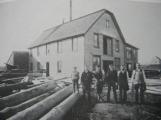 Credits:
Credits:Ralph S. Johnson 1986
North Shore Archives CSHC
17
Alexander specialized in carriage work, sleighs and sleds, using the second floor of the mill, where there was also space set aside for a sash and door shop, and an area for painting and finishing. Rough work was sawn at the rear of the mill, and woodworking was in the front part.With the addition of a new rail line, Denmark was growing. In 1904, it had a population of 250 people. Lumber was in high demand for homes, and steam mills were becoming increasingly popular in Nova Scotia.
18
Sutherland Steam Mill, Denmark, Nova Scotia, Canada2010
Denmark, Nova Scotia, Canada
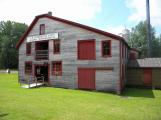 Credits:
Credits:S. Brinkhurst
19
The Sutherland Mill prospered. All winter, farmers would haul their lumber out to the mill. By spring, there were sometimes 60 piles waiting to be processed. Each pile had the owners name attached; the sawn timber would then be piled up along the approach road to the station.Winter in the mill was cold work for there was little in the way of heating. Some of the employees stayed there, sharing sleeping accommodation.
The new sawmill was powered by a steam engine from Amherst, and provided year-round employment for 4-5 men with another nine workers employed in the spring to help in the sawmill.
In 1910 John Thomas bowed out of the partnership, and the company continued to operate with the help of Alexander's son, Wilfred. The company's name became A. R. Sutherland & Son, General Woodworking.
20
Sutherland Steam Mill Machinery, Denmark, Nova Scotia, Canada2010
Denmark, Nova Scotia, Canada
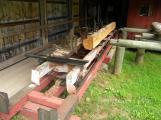 Credits:
Credits:S. Brinkhurst
21
A lad of 14 had the task of collecting huge barrels of water four times a day to supply the mill. In wintertime he had to feed the horses and harness the wagon well before dawn and before making the first trip. He was constantly cold and wet. He slept at night in a room with 3 others and he earned very little. The only source of heat in the mill in winter was from the steam boiler.Thomas moved to Western Canada and Alexander continued the business alone until his son, Wilfred, was of an age, at 16, to help. The company went in to general woodworking although repairs were made to carriages and sleighs.
A World War II building boom, with timber exported to England and post war demand, meant the mill business could be expanded. Despite fluctuating economic times and a declining population, business was still good but eventually the mill closed, although Alexander still maintained it.
Alexander died in 1953, and a short while later his son retired and the business closed in 1958. In 1975, the Nova Scotia Government acquired it for a museum, restored the building and machinery and made the steam engine operational; it is a fascinating place to visit.
22
Portable Steam Engine, North Shore, Nova Scotia, Canada1915
North Shore, Nova Scotia, Canada
 Credits:
Credits:North Shore Archives CSHC
23
With the coming of the portable steam engine, areas of prime timber could be opened up. A company or steam engine owner bargained with a wood lot owner, paying good money depending on the size of the lot and the timber growing there. A farmer could supplement his income this way.24
Hayman Steam Sawmill, The Falls, Nova Scotia, Canada1910
The Falls, Nova Scotia, Canada
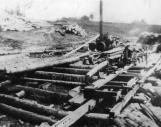 Credits:
Credits:North Shore Archives CSHC
25
This engine was owned and worked by the Hayman brothers, but originally owned by Dan MacKay Sr.Built with wheels or skids, these could be towed by horse or oxen to wherever it was needed.
Remains of old engines can still occasionally be found in the backwoods.
This shows the 'skidway' - logs were rolled onto it, then moved to the saw and made into planks. It was run by 25hp, self-propelled 2-speed boiler, and had one reverse gear.
Milling sites such as this, lasted perhaps a few years before moving on to a new area.
As well as a good supply of timber, an adequate and accessible source of water determined the site of a mill. A camp to house and feed the crew and horses would be established and a crew of 10 men or more moved in as soon as the ground froze and there was sufficient snow for easy sledding.
26
Hayman's Sawmill, The Falls, Nova Scotia, Canada1910
The Falls, Nova Scotia, Canada
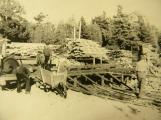 Credits:
Credits:North Shore Archives CSHC
27
In this earlier picture, at a Hayman milling site, no 'plank edger' is in existence. It was important to remove the accumulating sawdust, and wheelbarrows carried it to a pile where it eventually became fuel for the furnace. These sawdust mounds can still occasionally be seen in derelict mill sites.There was a 'pecking order' when it came to jobs on the sawmill site. Collecting sawdust and filling wheelbarrows was not high on the list, but it was an essential task.
There was little in the way of entertainment for the men when work finished, but usually there was someone who could play the fiddle, and provide lively tunes to tap ones feet to or sing along.